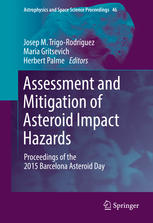

Most ebook files are in PDF format, so you can easily read them using various software such as Foxit Reader or directly on the Google Chrome browser.
Some ebook files are released by publishers in other formats such as .awz, .mobi, .epub, .fb2, etc. You may need to install specific software to read these formats on mobile/PC, such as Calibre.
Please read the tutorial at this link: https://ebookbell.com/faq
We offer FREE conversion to the popular formats you request; however, this may take some time. Therefore, right after payment, please email us, and we will try to provide the service as quickly as possible.
For some exceptional file formats or broken links (if any), please refrain from opening any disputes. Instead, email us first, and we will try to assist within a maximum of 6 hours.
EbookBell Team

0.0
0 reviewsThis volume is a compilation of the research presented at the International Asteroid Day workshop which was celebrated at Barcelona on June 30th, 2015. The proceedings discuss the beginning of a new era in the study and exploration of the solar system’s minor bodies. International Asteroid Day commemorates the Tunguska event of June 30th, 1908. The workshop’s goal was to promote the importance of dealing proactively with impact hazards from space. Multidisciplinary experts contributed to this discussion by describing the nature of comets and asteroids along with their offspring, meteoroids. New missions to return material samples of asteroids back to Earth such as Osiris-REx and Hayabusa 2, as well as projects like AIM and DART which will test impact deflection techniques for Potentially Hazardous Asteroids encounters were also covered.
The proceedings include both an outreach level to popularize impact hazards and a scientific character which covers the latest knowledge on these topics, as well as offering proposals of promising new techniques that will help gain new insights of the properties of these challenging bodies by studying meteoroids and meteorites. Asteroids, comets, meteoroids and meteorites are introduced with descriptions of their nature, origin, and solar system pathways.